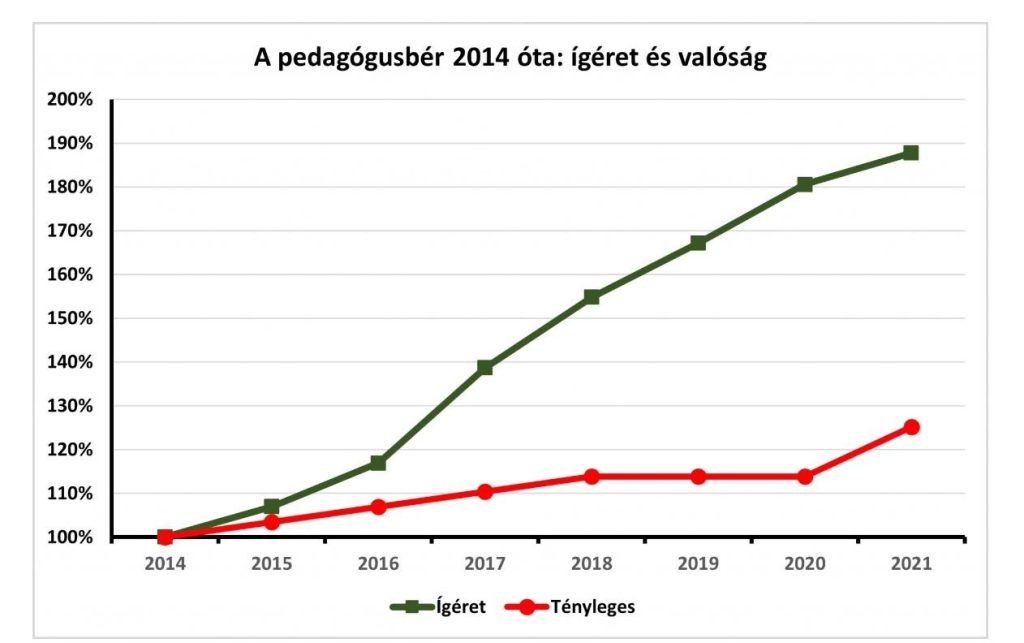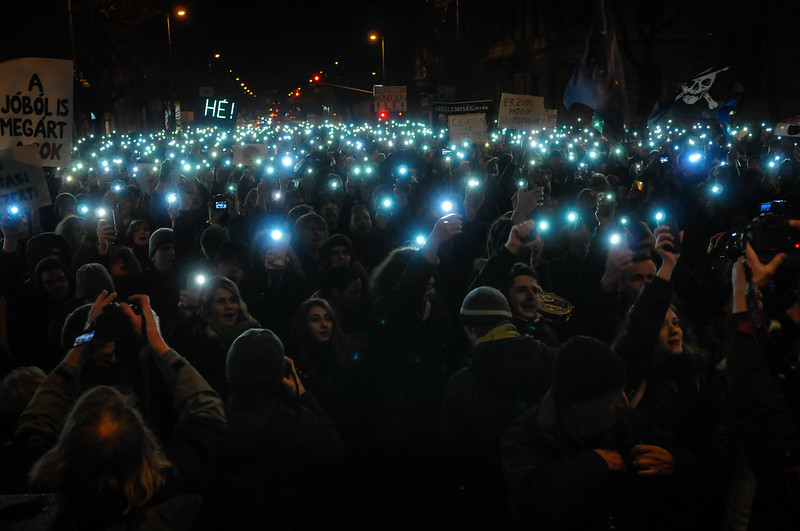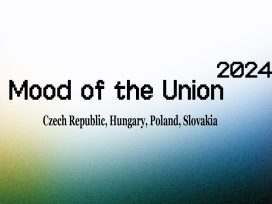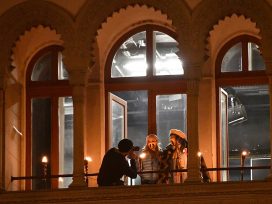Teachers in Hungary are on a wildcat strike and pupils are demanding their pedagogues be paid. Public education has long been at the forefront of the Orbán administration’s centralizing frenzy, which exploits the country’s traditional hostility toward workers’ advocacy. But those caught in the system are more determined than they’ve been in decades.
‘Pay our teachers already!’
This has become a major slogan in the Autumn of 2022. By now, even the representatives of the governing party, whose communication is strictly controlled by party discipline, admit that teachers’ salaries need to be increased. Yet they insist that the pay raise can only happen if the Hungarian state receives the reconstruction funds still withheld by the European Union – on grounds of the government’s non-compliance with basic democratic criteria. In other words, they blame the EU’s requirements on the rule of law for the repeated delay in rising salaries, which is in fact the result of a decade-long government policy.
The reign of the current Hungarian government is nearing 13 years now, during which the issue of public education has turned into a powder keg, as the Orbán administration has been unwilling to engage in meaningful negotiations. An unprecedented level of centralization has been implemented in public education, resulting in institutions struggling to deliver even basic tasks.
Pedagogical work is governed by decrees, and the autonomy of teachers and principals has been all but abolished. Teachers’ salaries are inconceivably low, the lack of professionals is crippling institutions, and the pandemic damage was left unmitigated. The performance of Hungarian students is consistently worsening in international assessments, and the number of students applying to Hungarian universities is also steadily decreasing.
By 2022, the government effectively abolished teachers’ right to go on strike by a decree, so professionals started to resort to civil disobedience. Last autumn saw the rise of open threats and politically motivated layoffs. However, more and more teachers, students and parents refuse to give up the protest.
Olivér Pilz, a teacher of Herman Ottó High School in Miskolc, was one of the first protesters as well as among the founders of the Tanítanék Mozgalom (I’d Like to Teach Movement). His teacher’s diary follows the developments of the past thirteen years, which brought Hungarian public education to a breaking point.
An overdone law
29 May 2010: With a two-thirds supermajority, Viktor Orbán’s Fidesz party forms government, starting a yet unprecedented stay in power in post-socialist Hungary. Its programme is announced as the System of National Cooperation (Nemzeti Együttműködés Rendszere – NER).
Education is classified under the Ministry of Human Capacities (Emberi Erőforrások Minisztériuma, EMMI) – along with the sectors of social care, health care, and culture, among others. Substantial resources are immediately withdrawn from these areas as a way of dealing with the economic crisis, ongoing since 2008.
Against the backdrop of a fortified parliamentary majority, a factory of laws is launched, fundamentally reshaping the legislative environment in Hungary. The constitution is replaced by a new basic law without any preliminary consultation with anyone. In quick succession, so-called fundamental laws are made, cementing the government’s will into the legal system. Election and media laws are among the first to be radically revised.
As citizens’ democratic tools are being hopelessly reduced, the power of the government grows more and more unshakable.
29 December 2011: The Act on National Public Education is published. During its parliamentary debate and voting, civil organizations demonstrate in front of the Parliament in the freezing winter weather. Some people saw it immediately that this legislation adjusts rules to the needs of the ruling parties and would soon weaken the already quite unstable foundations of education in Hungary.
The problems of the system are not new. In international assessments, the performance of Hungarian students is rather poor. Yet, few suspect that even this level would become a dream beyond reach within just a couple of years. Despite the obvious problems, the situation of education is out of the focus of society’s attention, addressed only by small communities of professionals.
At this point, most teachers still believe that these changes might improve the education system. In the autumn, State Secretary for Education Rózsa Hoffmann embarks on a national roadshow with the proposed law: a lifelong career model, promising higher salaries and chances of professional advancement. The events do not allow asking questions.
1 September 2012: A sudden and total centralization in the school system: a central body is established, assuming command over public education institutions previously maintained by local governments. The Klebelsberg Institutional Maintenance Centre (Klebelsberg Intézményfenntartó Központ, KLIK) also becomes the employer of teachers. School principals are deprived of many of their prerogatives, including financial management and employment. Local communities suffer a similar loss: local governments can no longer maintain schools in Hungary.
1 September 2013: The proposed lifelong career development model for teachers comes into force. This includes a teacher rating scheme, a new time register system, and the promise of higher, stable-value salaries calculated on the basis of the minimum wage, supposed to compensate for the increased burden of work and administrative tasks.
Although the numbers look good on paper, pay raises are stretched out until September 2017, referring to economic reasons as an explanation.
In the 1990s, teachers used to teach an average of 18 classes a week. In the 2000s, a uniform 22 classes were expected of pedagogues. Starting in 2013, the Act on National Public Education demands 22–26 classes a week from teachers – for an unchanged salary. Some work almost 20% more than others, yet their salary is unchanged. The working conditions will soon result in a crippling shortage of teachers, and this crisis will smooth out the differences: by 2022, the average is close to 26 classes taught a week.
The state breaks the agreement
29 December 2014: The 2015 budget is published. It breaks the government’s agreement with teachers – after slightly more than a year – by modifying the act on public education, which formerly guaranteed a higher and stable-value salary for the increased workload. From this point, teachers’ salaries are calculated on a single projection, effectively freezing wages at a 2014 rate for the rest of the decade, even amid unprecedented inflation and a cost-of-living crisis.

Pedagogues’ wages since 2014: official promises contrasted by reality. Source: szuloihang.hu.
As a result of that provision, the value of earnings of teachers from kindergarten to high school started to drop in comparison to wages in other sectors of the Hungarian economy. This disparity was relatively slow initially: in 2014, teachers’ salaries reached approximately 70% of the average graduate salary, so the wage tension had not yet triggered a mass exodus of pedagogues.
The afterlife of an open letter
September 2015: The provisions of the Act on National Public Education came into effect gradually, so the bitter fruit of their combined effect has ripened only by this time. Teachers are no longer able to cope with the growing number of classes and the increased additional workload. The work of a pedagogue doesn’t only mean teaching the actual classes, but also preparing for them, grading papers, selecting or creating visual aids, coaching students for competitions, organizing programmes, staying connected with parents, and, of course, caring for the children emotionally and socially, beyond academically educating them.
On top of all this, revisions of school documentation and the escalating administrative tasks also put pressure on the teachers. Many of them cannot even complete these tasks during the time they are obliged to spend in school because many buildings are not suitable for efficient work due to their long-neglected condition.
Like in many schools all over Hungary, numerous teachers at the Herman Ottó High School in Miskolc start to face the tasks awaiting them only now.
The faculty are overwhelmed. It is only the beginning of November and they’re already exhausted. They decide to make a list of the issues and to write a letter to the maintainer of the school, asking to forward their message to decision makers.
5 January 2016: The text written by the teachers of Herman is published as an open letter. It’s a cry for help, outlining the fundamental problems of Hungarian education affecting the entire system, summarized from the perspective of high school teachers concerned for children and the future of schooling. The letter goes viral in the media. Eventually, 35 thousand individuals and 950 communities (schools and other organizations) sign it online. The Tanítanék Movement is born.
Tanítanék postulates education as the most important national cause affecting the future. The representatives of the movement are practicing teachers, presenting their problems in a comprehensible way, taking into account everyday experiences. Many of their topics are not articulated by trade unions, even though they are conventionally expected to represent the interest of employees.
The news and the success of the letter cause government communication to freeze for days. They are at a loss in the face of the unexpected mass criticism. The first to speak in the press is István Klinghammer, a former state secretary of higher education, : ‘That’s why I’m so pissed-off when I watch the TV and see these unshaven, dishevelled teachers rampaging in their plaid shirts’. Upon this remark, the plaid shirt becomes the symbol of protests for education.

The plaid pattern as a symbol of teachers’ protests. Photo courtesy of Gabriella Csoszó, Freedoc.
First out in the street
3 February 2016: The local branch of the National Teachers’ Trade Union (Pedagógusok Szakszervezete, PSZ) is organizing a demonstration in Miskolc in support of the teachers of the rebellious Herman high school and the content of their letter. Many people come from all over Hungary.
This is the largest demonstration outside the capital for the cause of education, and the most popular such event in Miskolc so far, numbering 5,000 participants on a cold, rainy day. ‘For our children!’ reads the banner carried at the front of the demonstration.
Under false pretences
9 February 2016: The Round Table for Public Education is established. It’s a forum mimicking democratic concord but lacking all necessary functions: its mode of operation and agenda are defined by the government, its members invited on the basis of political loyalty. Later we’ll see directors of education make statements about the results even before the respective meeting would start – evoking legendary scenes of the 1950s Soviet-era show trials. It is also deliberately admitted that the decrees of the Round Table for Public Education do not oblige the government to any action.
10 February 2016: Elected representatives of the Tanítanék Movement summarize their expectations for education management in 4 points. They demand professional, in-depth consultations, legislation for public education, a budget increase, and immediate solutions to everyday problems.
What are these problems? The most notorious example is that even chalk is often missing in schools. But there is no printing paper or toilet paper either, Internet access is often unavailable, and the digital class register keeps breaking down. Institutions wait weeks, months, or even years for necessary procurements.
The state-sanctioned amount of knowledge is impossible to teach, or to learn. The curricula aren’t appropriate for the age of the children, and they are severely outdated for the twenty-first century.
Instead of competency-based training, as advised the world over by the OECD, the curriculum requires an outdated, quantitative education in old-timey Prussian style. Moreover, it insists on a type of quantitative learning that condemns both teachers and students to fail. More and more often, already overwhelmed teachers are forced to substitute for colleagues, many of whom fall ill due to the increased pressure or are absent trying to meet their obligations in a new qualification process.
Due to the shamefully low wages, supporting staff is also decreasing. Pedagogical assistants, special education assistants, laboratory assistants, extracurricular organizers, child and youth protection workers are supposed to round out and streamline the pedagogical work and lift the burden off of teachers. But due to wage freezes and budget cuts, they are going extinct, leaving part of their work for the teachers.
Infrastructures are falling into disrepair: buildings are in disarray, even sanitary paintjobs are being spared. The toilets and changing rooms are the fastest to deteriorate. Lab equipment is insufficient, materials are running out. If an experimental device is broken, it is never repaired or replaced. Reports surface from schools where even windows cannot be properly closed: they are nailed up in the winter and left open from spring until autumn.
Uniform, obligatory textbooks are introduced; they are supposed to be ‘lasting’, but new ones keep being introduced year after year, so teachers don’t have the opportunity to get acquainted with them. Never mind, because many of the books are teeming with mistakes and errors, and in certain cases, questionable political messaging.
The legislation also keeps changing, which leads to the rewriting of school documents over and over. The quality of public catering is disgraceful – practically, we are teaching an entire generation to give up eating a hot meal.
The list is much longer – these issues are merely a taste of the problems crippling the system.
Under the umbrellas
13 February 2016: The National Teachers’ Trade Union organizes a demonstration in Budapest. 35–40 thousand people march before the Parliament. Never before has such a crowd mobilized for education in Hungary. Unions of several other trades declare solidarity.
It is colloquially known that throughout recent decades of Hungarian history, important protest moments tend to be met with bad weather in this otherwise quite dry and sunny region. A running joke has developed about dissenters having to contend with the elements. In casual conversations, the effect of a speech or a demonstration is often measured by how many people stood their ground in the rain. This seems to apply to the education protests too. The weather is not kind this time either, it is cold and raining again. The event is characterized by an eery, stubborn silence as raindrops tap ominously on the umbrellas of the vast crowd. The event will go down in history as a protest under umbrellas, earning the movement a new symbol: the chequered umbrella.
29 February 2016: ‘Don’t go to school!’ The action is a parental initiative to support protesting teachers. Plenty of parents keep their children at home. Some institutions are almost empty. The organizers soon launch the Parental Voice Community (Szülői Hang Közösség), which will survey and campaign focusing on textbooks, the shortage of teachers, compulsory schooling, and more.
9 March 2016: A public opinion poll is published, according to which 76% of society supports the cause of education and the demands of teachers.
The secretary of state László Palkovics promises to introduce a new, modern Hungarian National Core Curriculum (Nemzeti Alaptanterv, NAT) to reduce workload still within the calendar year.
15 March 2016: National holiday. The Tanítanék Movement protests in front of the Parliament, drawing a crowd of 50,000 people, and their umbrellas. It’s raining again. The slogan of the event: ‘You have no power over us!’.
By this moment, a new division is arising in the field of education: a tension between public schools and religious institutions. The education policy of FIDESZ has been designed to disproportionately favour schools run by churches, already during the first reign between 1998 and 2002, and permanently since 2010. These schools enjoy higher state funding and more autonomy from the central government, effectively creating a whole separate sphere of education.
But public education is isolated on further levels, too. Vocational schools and higher education are separated from public education and classified under a different ministry. In vocational education, one reform comes after the other, and the teachers working there are no longer civil servants.
The autonomy of universities is curtailed. First, omnipotent chancellors are appointed by the government in top management positions. Later, the last legal guarantees of autonomy are eliminated by effectively privatizing many universities, handing them over to foundations operated by government delegates.
Strike rights struck down
30 March 2016: The Tanítanék Movement announces its first wide-scale civil disobedience action. Thousands of teachers participate. Many people working across other sectors express support and solidarity, but only a few of them stop working for at least an hour, as suggested. The country does not stop.
By this time, the government has already made legal amendments which effectively outlawed the conventional means of a workers’ strike. The remaining forms of legal strike are essentially imperceptible: the majority of classes must be taught as normal, and the supervision of children must be ensured in every institution. This is why the strike law becomes the central issue of the later protests: from this point on, teachers will add to their demands that the basic right to strike be guaranteed for them as well.
20 April 2016: A national teachers’ strike is called by trade unions. They also ask the entire country to stop for at least 5 minutes, since education affects everyone. It is about our children, our future!
Hungary being a post-Soviet country, its society harbours a deep aversion to conventional means of workers’ self-advocacy. Trade unions have traditionally been coopted by the communist leadership, and never gained a new form after the regime change. Strikes are relatively rare to begin with, but the idea of a general strike across sectors is as foreign as it gets. So merely proposing it takes a lot of gumption from the unions who, after many decades of conformism and conflict avoidance, have only recently started to experiment with more confrontational tactics.
This time, the entire country does not stop, but 25,000 teachers participate. The government is doing its worst to discourage workers. In many instances, headmasters forbid teachers from going on strike, even though such bans are clearly illegal. The social security status of many participants is suspended for the duration that they refused to take up work – another illegal move. Those involved will have to undergo a lengthy administrative process to restore their rights.
Central political propaganda is launched against the protesters. One character assassination follows the other. This time it isn’t restricted to teachers anymore, it also targets pupils.
Summer of 2016: A crucial background organization, the Institute for Educational Research and Development, is dissolved. Vocational training is transformed at breakneck speed. A pedagogical degree is no longer required of those teaching vocational theoretical subjects – an administrative trick to alleviate the more and more acute shortage of teachers.
In several schools, application processes for the position of headmaster end unresolved, even though everything is legally correct and the faculty support the applicant. Many of the involved candidates had been photographed in plaid shirts – and protesters suspect political reasons behind these decisions.
In the next two years, the Tanítanék Movement organizes several further demonstrations and, out of solidarity, participates in similar events organized by other groups protecting employee interests in other sectors.
However, the demonstrations focusing on public education won’t be able to mobilize the crowds of February–March 2016 until 2022. Known in Hungary as ‘salami tactics’, the government’s policy to divide and conquer shows success: teachers are fragmented, and their popular support is not yet very high.
In the meantime, higher education is the subject of popular demonstrations: the pressure on the Central European University (CEU) and then the University of Theatre and Film Arts (Színház- és Filmművészeti Egyetem, SZFE) mobilize great masses and dominate public discourse for a long time.
Alternative facts sanctioned by the state
19 December 2016: The Civil Platform for Public Education launches the Chequered Book. This analysis, subtitled The Way out of the Education Disaster, is a strategic document proposing a complete reform of K-12 education in Hungary. The purpose of this text produced by professionals is to trigger social debate, initiating the process of the reform, which must be realized as the result of an extensive social consultation.

The Chequered Book by the Civil Platform for Public Education.
Since then, numerous professional documents have followed the Chequered Book, proposing solutions based on real expertise (for example, One Hundred Points for the Renewal of Public Education, alterNATtive, Educational Minimum, Hungary Turns Its Back on Europe).
New legislation goes down in infamy as the Taygetus Act. It affects about one hundred thousand students with learning and behaviour difficulties, and/or special needs. In effect, this regulation tasks teachers with the integration of these students, a role for which they aren’t prepared, and do not get professional support.
March 2017: Establishing new schools becomes the exclusive privilege of the corresponding minister. Vocational schools under the Ministry for National Economy are subject to a news blackout: they’re barred from talking to the press.

‘Don’t go to school’ demonstration in January 2018. Photo courtesy of Gabriella Csoszó, Free Doc.
The number of Hungarian university students is drastically decreasing, teacher training candidates can hardly be found. In 2019, vocational training will be reformed for the fourth time.
Stakeholder participation is abolished in the selection process of school headmasters – teachers, parents, and students can no longer have a say or even voice an opinion. Instead, the leaders are appointed by the centralized education authority, without examining their professional suitability or any other limitations.
PSZ conducts a survey on the workload of teachers, revealing that teachers work an average of 56 hours per week for humiliating salaries.
Pandemic freefall
31 January 2020: The new curriculum prescribes an information overload. In certain subjects, the expectations are aligned to the ideology of the governing parties. This is especially true of Hungarian literature and history, but parents report problematic materials in biology textbooks as well.
The required amount of knowledge is unrealistic; even the most diligent students wouldn’t be able to acquire it all. Moreover, teachers themselves are unable to teach it within the given time frame.
But the biggest problem is that the curriculum demands students to memorize a lot of unnecessary data, information that is now available to anyone in an instant with one click. These goals take away valuable time from competence development and team-based problem solving.
There is no real professional or social consultation, so the uproar is huge. Apart from the closest government circles, practically everyone speaks out against the new national curriculum. NGOs start organizing demonstrations for March.
11 March 2020: In the morning, the idea of school closures is called an opposition conspiracy by the Orbán government. Teachers are threatened with the withdrawal of their wages, should they refuse to hold classes in person. In the evening of the same Friday, the prime minister announces school closures. Full lockdowns expect all to shift to digital work as of Monday.
As for the implementation of the directive, teachers are left to their own means, practically abandoned by the educational government. As a result, individual solutions range from high-quality practices to unacceptable ones. Unlike in many EU countries, parents staying at home with their children do not receive any state support – in Hungary, there is no compensation from the state for any quarantine, and no social benefits are introduced across the first two years of the COVID lockdowns.
This is the moment when masses of parents truly face the difficulties of teaching and learning, the shocking amount of outdated information prescribed, and the age-inappropriate expectations.
The teachers who try to adapt to remote education work impossible hours, even exceeding their previous overload.
When the first vaccines appear in the spring of 2021, teachers are left out from the national vaccination schedule, even though they are expected to keep teaching among unvaccinated children. Teachers’ demand for a vaccine priority is discussed by the government as selfish, as if they merely wanted to jump the queue at the expense of others.
Mass in-person events are impossible for a long time, so spectacular protests aren’t held across this time period. However, the independent press and social media platforms are dominated by the problems revealed by homeschooling.
1 September 2020: The school year starts without a pandemic strategy or contingency plans. In the second wave starting at that time, Hungary’s COVID death rates lead global statistics for months.
According to an OECD report, Hungary is among the countries with the biggest difference between teachers’ salaries and the average graduate salary. At the same time, it has the highest number of mandatory classes.
Anarchy in the nursery
Chaos prevails in early childhood education as well: in an attempt to cover up the shortage of kindergarten teachers, the government declares that pedagogical assistants can look after the children in the afternoon, without the presence of a professional teacher.
The lack of nursery and kindergarten places has already been covered up through administrative means: the officially permitted group size was simply increased without increasing the actual capacity at all. This area is characterized by overcrowding, overwork, and a chronic lack of professionals, even though the years spent here determine the entire academic career of children.
The chaos of the previous year in school epidemic management is repeated across 2021. There is no contact tracing, no free or affordable testing, but there are expensive and useless ‘fever gates’, measuring the body temperature of people entering the building. To switch to remote education, classes need a permit from the same centralized authority that had already choked up on slow-paced peacetime maintenance. This time, when the disease is traced in a class, directors give a signal to the authorities. Responses, however, often lag until the end of the mandatory quarantine period. The virus spreads uncontrollably.
The academic year passes with the uncertainty and anxiety known from the previous semester. The epidemic leaves its mark on everything. Isolation increases. School life becomes dull.
Students miss the most important events of the school year. Masses of students and teachers are absent. Some people participate online, and some will never be seen again.
After a long period of denial and beating around the bush, the second general quarantine is declared in Hungary, starting on 8 March 2021. Schools are closed, but shopping malls are not. Flower shops are granted an additional day to keep open – aptly representing the Orbán administration’s general idea of International Women’s Day.
Heads rising, backbones straightening
Autumn and winter 2021: The National Teachers’ Trade Union (PSZ) launches a petition against the freezing of salaries since 2017 and for changing the number of mandatory classes per week. The Democratic Trade Union of Teachers (Pedagógusok Demokratikus Szakszervezete, PDSZ) conducts a survey revealing that education and childcare workers essentially live in poverty.
Inflation in Hungary hits record rates early in the year – and this is only the beginning.
31 January 2022: Both the PSZ and PDSZ declare a warning strike. At least 20,000 teachers are going to join. The Parental Voice Community pleads with parents to keep their children at home on January 31 – and many oblige. The ADOM Movement, a student group, also supports the work stoppage.
The government is trying to legally hamstring the workers’ strike. After a long legal battle, it turns out that the teachers were right.
11 February 2022: Taking advantage of the rule-by-decree policy based on the epidemic emergency, the government limits the teachers’ right for strike, restricting legal means to invisible and imperceptible options.
14 February 2022: 12 teachers of Szent László High School in Kőbánya resort to civil disobedience by refusing to take up work. A banner is stretched on the facade of the building that reads: ‘Strike is a fundamental right!’
The following days see more civil disobedience in both Kölcsey High School in Budapest and Illyés High School in Budaörs. A chain reaction starts. For two months, there are one or two, sometimes ten or even more institutions every day, where teachers demand their right to strike, and through this they stand up for themselves, their profession, their students, and the cause of Hungarian public education. More and more people start to support them with sympathy. Most of all, students voice their sympathy and solidarity. Events are accelerating.
24 February 2022: Russia launches a full-scale attack on Ukraine. NGOs and volunteers quickly start to organize support, accommodation and care for war refugees. The Hungarian state doesn’t respond for weeks, and neither state resources nor central organizations are available for helping refugees during the most severe period. Only children who speak Ukrainian are admitted to Hungarian educational institutions.
The already high inflation starts to skyrocket. Fuel prices go through the ceiling.
16 March 2022: The trade unions’ indefinite work stoppage turns into a ‘rolling strike’: teachers stop work across different schools every day, holding out until the days before the elections. In downtown Budapest, students organize a demonstration in support of the teachers on strike.
From this point on, mass demonstrations become regular; protest concerts and happenings start to appear, which have been previously less common in Hungary. The voice of protesting students is getting louder.
3 April 2022: Parliamentary elections: FIDESZ wins an overwhelming victory over a more-or-less united opposition. the fifth Orbán government is formed with a supermajority.
Spring 2022: PDSZ asks Viktor Orbán to appoint an independent Ministry of Education in the new government. Instead, public education – in a unique way in Europe – is delegated to the Ministry of Interior. That means that during this government, a police minister is in charge of public education and several other areas, including health care and the entire social sector. The message is clear: order must be restored. But at what cost?
Insult to injury
24 May 2022: During the state of emergency, the measures of the decree on the teachers’ strike are enacted into law. Trade unions take the matter to court.
29 July 2022: The government submits its latest EFOP-Plus application to the European Union, in which it admits the lack of teachers, the work overload, and the low wages – all the issues it has been publicly denying for years. The application’s claims for education funding echo protest demands from previous years.
From this point on, Brussels becomes the centre of the blame game. The Orbán administration had been propelling anti-EU propaganda and waging operetta wars on Brussels for years. Yet now it wants EU development funds to cover teacher salaries – a field of public administration which clearly belongs to the realm of national self-determination. Talking points are piled atop one another, the communication machine doesn’t bother ironing out the details.
1 September 2022, start of the new school year: There is an unprecedented shortage of education professionals all over Hungary. Due to low salaries and ever-increasing cost of living, more and more educators are left in poverty. The Tanítanék Movement announces a rolling civil disobedience campaign, and trade unions call to continue the strike where they left it last spring.
The kids are determined
2 September 2022: ‘The future of education is our common cause’: a solidarity demonstration organized by the Students for Teachers (Diákok a Tanárokért), an organization created by high school students. Members of Tanítanék, PSZ, and PDSZ, parents, grandparents and other solidarity groups march together with the students.
9 September 2022: Disobedient teachers receive uniform threatening letters, and the first retaliation takes place: the deputy head of the Herman Ottó High School in Miskolc is removed. The next morning the high school building is surrounded by a human chain: several thousand people come dressed in black, and thousands of students march through the city to hand a petition to the head of the school district. In the following weeks, hardly a day goes by without solidarity actions across the country.
30 September 2022: After participating in another act of civil disobedience, five teachers are fired from Kölcsey Grammar School in Budapest. A public uproar sweeps across the country: solidarity actions are held in front of schools and school districts, on streets, squares, and bridges. The slogan is: ‘Hands off of our teachers!’
‘Pay our teachers already!’ – students and parents chant. Workers’ strikes and civil disobedience continue. Student, parent, and teacher advocacy groups are mushrooming across the country, organizing local or national events. Pupils who found official student self-governments insufficient form independent groups and consultation platforms.
23 October 2022: Hungary’s most revered national holiday, the anniversary of the anti-Soviet revolution of 1956. On this day in 2022, the tension is palpable. By this time, Viktor Orbán is Vladimir Putin’s last remaining ally within the European Union. For the first time in his political career, he does not give a public speech in Budapest but at a private event in the western city of Zalaegerszeg. Even though Fidesz parades have dominated this date for many years, this time there is no centrally organized celebration in the capital. This move widely interpreted as an excuse to escape from the public. In Budapest, about 80,000 people – so far, the biggest crowd – gather to demonstrate their solidarity with teachers and public education, with trade union leaders of other sectors also pledging their support.
In towns and cities across the country, crowds are marching in numbers unseen since the famous 2014 Internet tax protests.
A mass demonstration is held in Budapest. At the suggestion of Ákos Hadházy, an independent Member of Parliament, the crowd demands that the public media, which otherwise broadcasts government propaganda, should report on the protests fairly and factually. Student organizations start to demand screen time.
2 January 2023: Teachers, supported by students and parents, march 180 kilometres in six days from the Ottó Herman Grammar School in the northeastern city Miskolc to the Ferenc Kölcsey Grammar School in Budapest. Right before Christmas, more disobedient teachers were sacked, now counting 14 politically motivated layoffs.

Marching from Miskolc to Budapest. Photo courtesy of Gabriella Csoszó, Free Doc.
Paying his first visit to any such event since assuming the responsibility, the minister of interior blames teachers for the problems of public education in a mock consultation.
In reaction to this pretend negotiation, and the latest sackings, a number of teachers have prepared their resignations, unless the demanded changes are enacted soon.
23 January 2023 A full week of work stoppage starts in Hungarian public schools. A number of private schools join in solidarity.
Faced with the cost of living crises and having born the brunt of the pandemic strain, teachers are also on strike across Portugal and the UK. It is yet to see, whether the Hungarian government will be able to pivot from its iron fist policy.
Published 20 January 2023
Original in English
Translated by
Katalin Szlukovényi
First published by Eurozine
© Olivér Pilz / Eurozine
PDF/PRINTNewsletter
Subscribe to know what’s worth thinking about.
Related Articles

Prefiguring Europe’s future
Czech Republic, Hungary, Poland, Slovakia
Since the war in Ukraine, the Visegrád Four group no longer articulates a common voice in the EU. Even the illiberal alliance between Hungary and Poland has come to an end. Yet in various ways, the region still demonstrates to Europe the consequences of the loss of the political centre.

Pronatalism has become a populist vote winner for right-wing parties in Central and East European countries. Demographic imbalances, involving youth migration, ageing populations and immigration resistance, have sparked a series of baby-making policies. But are financial incentives in Hungary, Poland and Serbia enough to reverse the trend of decreasing birth rates?






